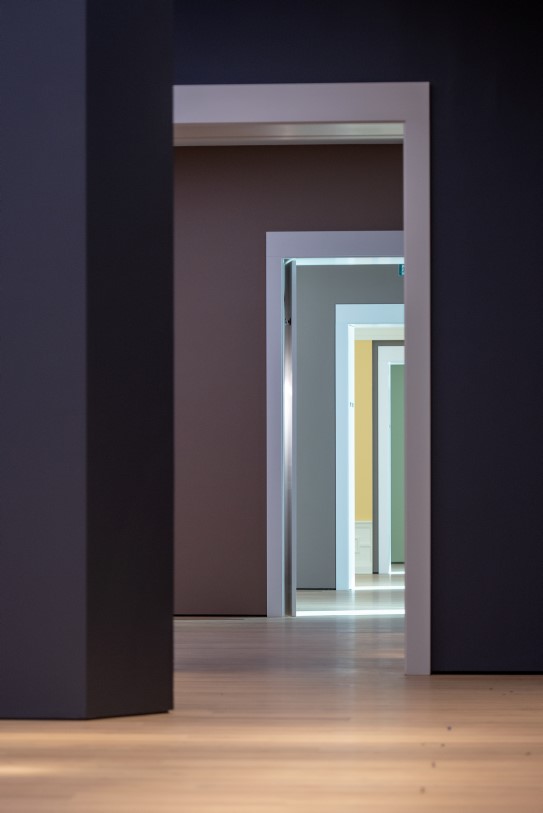Rooms for Exhibitions

Transcription
Narrator:
How do you build a national museum that is both classical and modern? A building with an interior that can be changed and adapted continually to cope with new requirements and technologies, and that can give visitors a better experience of their national treasures and art?
When building a new museum, the first thing to think about is the objects that will be inside it. When the architectural competition was announced, the National Museum provided many guidelines.
The fundamental question was: How can we display 3000-5000 artworks and objects from different periods and artistic disciplines in one and the same building?
There was a need for large galleries, smaller rooms, flexible areas that could be adapted for different kinds of exhibitions, intimate spaces for small objects and large spaces for monumental artworks. There had to be areas where visitors could rest and a multitude of different routes through the exhibitions to cater for visitors with different interests and objectives.
Once the architectural framework was clear and the curators began to gain an overview of what would be put on display, exhibition designers and interior architects came into the picture.
There are a lot of challenges involved in building a new museum where no one has worked before, and everything is happening for the first time.
Marco Magni:
It's very rare that somebody makes a national museum like this all together from let´s say nothing. So it was very important to share the process.
Narrator:
This is Marco Magni, founder of the Italian architectural practice Guicciardini & Magni, which specializes in exhibition design. They won the competition for the largest commission for exhibition design in Norway’s history.
To help with the planning of the displays and exhibitions in the new building, it was necessary for Marco and his team to make sketches with measurements of every object that the museum wanted to display. That gave them an overview of proportions and dimensions – and also of the total volume of objects and artworks. Thousands of sketches later, the exhibition architects and museum staff could begin to plan the actual displays in accordance with the architecture of the building.
Cristina Rizzello:
Every decision we made, we made together with people that work at the museum. At any level from conservator to technicians.
Narrator:
Exhibition architect Cristina Rizzello relocated to Oslo to follow through the entire process and to study Norwegian identity.
Cristina Rizzello:
Yes, it's essential for us to us to study and to try to understand what's the purpose, because we are talking about a national museum so in a way it´s the story of a nation.
Narrator:
Designing an exhibition space is almost like telling a story – it's important to have a beginning, a middle, and an ending.
Cristina Rizzello:
The way to approach to design it´s for us a way to translate the meaning of the objects, of the art works and convey the story that the curators want to express in a particular room or for a particular object. And we try to translate it into something visual, like an exhibition display.
Narrator:
The National Museum at Vika has three floors of exhibition space.
The permanent collection exhibitions on Floors 1 and 2 are displayed chronologically.
The displays on Floor 1 are mainly of design and applied arts, while Floor 2 is home to paintings, sculptures and exhibitions about architecture.
This required a completely unique approach from the exhibition architects.
Cristina Rizzello:
At the first floor you will find objects within cases, display cases, so most of the collection is protected in very beautiful and also very complex machines.
In the second floor you will find mostly paintings and no glass – so the visit will be different.
Narrator:
Perhaps the biggest challenge with such a large museum is that there is a huge amount for visitors to take in. Where should you start? What do you want to see? This is something that Marco Magni has devoted a lot of time to:
Marco Magni:
We tried to create a rhythm where we have higher moments and lower moments, which are balanced, and we tried to avoid boredom, creating a great variation of specific installations based on the artworks and objects. So for example we introduced an important use of colors to distinguish the rooms, the sections that we have, and also many different shapes and specific installations.
Narrator:
In the permanent collection exhibitions, the visitor experience is enhanced by digital elements, such as video, audio and photography.
Cristina Rizzello:
Since it´s a long journey and we hope that people can come many times to enjoy the museum, not only once, then you will find every time a new thing to do.
Like the fairy tale room you will find a tree, you will hear the voice of animals – there are many different surprises. And you will find incredible artworks.